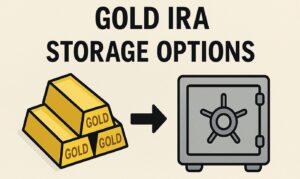If you’re turning 73, it’s time to start thinking about your Required Minimum Distributions (RMDs) — especially if part of your retirement savings is in a Gold IRA. Understanding how RMDs work with precious metals can help you stay compliant with IRS rules while keeping your wealth strategy intact. Whether you’re considering a cash withdrawal or taking your RMD in physical gold or silver, here’s how to navigate it smartly.
Understanding RMD Requirements for Gold IRAs
If you were born in 1951-1959, the IRS requires you to begin taking RMDs from traditional retirement accounts — including Gold IRAs. These mandatory withdrawals ensure that tax-deferred savings eventually generate taxable income.
How your RMD is calculated:
- Your RMD is based on your IRA’s December 31 value from the previous year, divided by your life expectancy factor from the IRS Uniform Lifetime Table.
Example:
- If your Gold IRA was worth $200,000 on December 31, 2024, and your life expectancy factor is 26.5, your 2025 RMD would be about $7,547.
Key deadlines:
- First RMD: April 1 of the year after you turn 73.
- Subsequent RMDs: December 31 of each year.
- Penalty for missing an RMD: 25% of the amount not withdrawn.
Can You Take RMDs in Physical Gold or Silver?
Yes. You can satisfy your RMD with an in-kind distribution — receiving physical metals instead of cash. This is often appealing for investors who want to hold onto their gold or silver outside their IRA.
Here’s how it works:
- Ownership transfer: Your IRA custodian transfers specific coins or bars to you personally.
- Valuation: The metals’ fair market value on the distribution date counts toward your RMD.
- Taxes: For metals that have been distributed (removed from the IRA), that same fair market value becomes your taxable distribution amount and your new cost basis for any future sale of all metals removed from the IRA on that date. Metals remaining inside the IRA are not taxable until they are distributed and their tax basis will be the their fair market value on the date they are distributed from the IRA.
- Delivery: Once distributed, you can have the metals shipped to you, stored privately, or sent to a secure vault. GoldSilver offers professional storage options through IDS Texas if you prefer to have your IRA custodian ship metals directly to a vault instead of your physical address. You’ll typically cover shipping and insurance.
Please Note: Even if you take your RMD in gold or silver, you’ll still owe taxes in cash on the distributed value.
Tax Implications of Precious Metals RMDs
Taking RMDs from a traditional Gold IRA means the value of the metals or cash you withdraw is taxed as ordinary income at your current rate.
For in-kind distributions:
- You pay taxes on the fair market value of metals received.
- If you later sell those metals, any gain above that value is taxed as a collectible (up to 28% capital gains rate).
Smart tax strategies:
- Plan distributions during lower-income years.
- Consider Qualified Charitable Distributions (QCDs) to offset tax liabilities.
- Coordinate withdrawals with other income sources to avoid higher brackets.
Strategic Ways to Manage Your RMD Precious Metals
You can meet RMD requirements while keeping your precious metals exposure with these approaches:
1. Partial cash distributions: Sell just enough gold or silver to meet your RMD and keep the rest invested for continued growth.
2. Rebalance your portfolio: Use RMDs as an opportunity to realign your asset mix. If gold prices have surged, taking distributions from this portion helps maintain balance.
3. Aggregate RMDs smartly: If you have multiple IRAs, you can calculate total RMDs and withdraw from just one. This flexibility lets you preserve your Gold IRA and withdraw from others.
4. Consider Roth conversions before RMD age: Converting some funds to a Roth IRA before 73 can reduce future RMDs — and Roth accounts have no lifetime RMDs.
Learn more about optimizing your gold IRA tax benefits to make the most of your retirement planning.
Step-By-Step: Taking Your RMD
Follow this timeline to stay compliant and organized:
- January: Calculate your RMD using your prior year-end account value and the IRS table. Estimate My RMD Here →
- February–March: Decide whether to take cash or metals.
- 60 days before your deadline: Contact your IRA custodian to initiate the process. Metals transactions may take longer to settle.
- If taking physical metals: Arrange secure delivery or storage outside of the IRA custodian.
- Keep records: Document valuations, distribution details, and tax forms (Form 1099-R).
Planning Ahead for RMDs in Precious Metals
Success with RMD precious metals starts with foresight. Work with a trusted custodian and tax advisor to:
- Understand how RMDs fit within your broader retirement plan.
- Minimize taxes while preserving your gold and silver holdings.
- Stay proactive with deadlines and documentation.
To learn more about traditional Gold IRAs and meeting RMD requirements, consider working with a qualified professional who can help you maximize your benefits and stay fully compliant.
Investing in Physical Metals Made Easy
Open an AccountConclusion
RMDs don’t have to derail your precious metals strategy. With thoughtful planning, you can meet IRS requirements, manage taxes efficiently, and maintain the long-term wealth protection benefits that drew you to gold and silver in the first place.
Disclaimer: GoldSilver is not a tax advisor. This information is provided for educational purposes only and should not be construed as tax or financial advice. Always consult a qualified tax professional for guidance specific to your situation.
People Also Asked
Can I take my RMD in physical gold or silver instead of cash?
Yes, you can take RMDs as in-kind distributions of physical precious metals. Your custodian will transfer specific gold or silver coins or bars from your IRA to you personally, with the fair market value as of the date of distribution, counting toward your RMD requirement.
What are the IRS rules for RMDs from a Gold IRA?
The IRS currently requires RMDs starting at age 73, with the first distribution due by April 1 following the year you turn 73. Subsequent RMDs must be taken by December 31 annually. The rules apply equally to Gold IRAs as traditional IRAs, with a 25% penalty for missed distributions.
How do I calculate the amount of my RMD for a Gold IRA?
Divide your Gold IRA’s December 31 value from the previous year by your life expectancy factor from IRS Uniform Lifetime Tables. For example: $200,000 account value ÷ 26.5 (age 73 factor) = $7,547 RMD.
What are the tax implications of taking RMDs from a Gold IRA?
RMDs from traditional Gold IRAs are taxed as ordinary income at your current tax rate. For in-kind distributions, you pay taxes on the metals’ fair market value when distributed. Future sales of those distributed metals may incur collectibles capital gains tax (maximum 28%) on any appreciation.
What strategies can I use to preserve my gold holdings while meeting RMD requirements?
Consider partial cash distributions (selling only what’s needed), using the aggregation strategy (taking RMDs from other IRAs), timing Roth conversions before RMD age, or combining multiple IRAs to optimize which assets you distribute while preserving your core gold holdings.
Get Gold & Silver Insights Direct to Your Inbox
Join thousands of smart investors who receive expert analysis, market updates, and exclusive deals every week.








